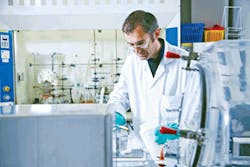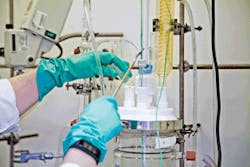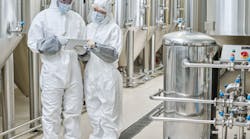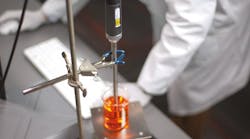As new chemical entities (NCEs) with greater molecular complexity enter drug development pipelines, the demand for hazardous chemistry techniques is growing.
Hazardous chemistry can provide access to synthetic routes for active pharmaceutical ingredients (APIs) which overall involve fewer process stages. These alternative routes of synthesis are not always considered during the earlier phases of development due to the risks involved. But, ultimately, these routes allow API manufacturers, with the right experience, to develop more direct and cost-effective processes that will produce higher yields.
However, it’s vital that manufacturers carefully assess the risks involved and have the necessary expertise and experience to review and manage the potential impacts of operating any process involving hazardous chemistry.
THE REQUIREMENT FOR HAZARD EVALUATIONIn Europe, Directive 2012/18 — Major Accident Hazards (MAHs) (Seveso III directive) requires that operators should take measures to prevent major accidents, and to limit their consequences for people and the environment. The demonstration is achieved by risk-based assessment.
Assessing the level of risk associated with a manufacturing process requires the identification and understanding of the inherent reaction hazards unique to that process. It’s recommended that every process manufactured, whether it’s at a 20-liter scale or 10,000-liter, undergoes a rigorous hazard evaluation. This will involve the process being subjected to a full run-through a reaction calorimeter (RC1) to identify heat outputs from reactions and quantify gas generation. At key points in the process, samples of reaction mixtures should be taken and assessed through differential scanning calorimetry (DSC). This screens for thermal activity and decomposition temperatures. In some situations, accelerated rate calorimetry (ARC) can also be performed. This process can identify thermal onset temperatures for runaway reactions and any associated pressure rises. A vent sizing package (VSP) can then be used to assess gas generating reactions and emergency venting requirements during scale-up.
Powder handling is one of the most significant causes of incidents within the process industries. As the most common compounds used in the manufacture of APIs are powders, it’s vital to identify hazards associated with their use. Tests including minimum ignition energy (MIE) identification, 20-liter sphere tests for dust explosion classification and electrostatic charge relaxation identification are recommended.
THE ROLE OF THE PROCESS ENGINEERCollaborations with development chemists and multidisciplinary process review meetings will help ensure that all details are shared and incorporated into the design. For example, does the reaction mixture thicken? Do solids suspend easily? If agitation is stopped, does the mixture layer? While a process engineer may propose changes to minimize the consequences of any hazards, this should not be done in isolation and additional testing and approval by a chemist should be sought.
Hazard identification and risk assessment can be conducted on the final design of a manufacturing plant using fixed process and piping and instrumentation diagrams (P&IDs). Should an MAH be identified, these will need to undergo more in-depth risk assessments that are proportional to the severity of the hazard. This may include a layer of protection analysis (LOPA) or a quantified risk assessment (QRA). If protective instrumentation is a requirement, the safety integrity level (SIL) will also need to be defined.
The need to consider alternative chemistry is one of the most common outcomes following a safety review. This could involve a change in solvent system, a different order of operation or alternative reagents. Again, collaboration is vital here and chemists and engineers must work together to minimize or eliminate all hazards.
If MAHs are identified, manufactures will be required to submit a report to the competent authorities in their region. This must provide an overview of the hazards, anticipated consequences/impact and control measures put in place. The overall premise is to demonstrate that the process is safe to operate within the nationally recognized levels. If the MAH is associated with the use of specific materials, manufacturers will be required to justify that the chemical route is the most appropriate for the desired molecular transformation. This needs to take into consideration the environmental impact, as well as the hazardous nature of the materials. The results of the hazard evaluations can be used in these circumstances to demonstrate why alternative routes present greater hazards.
PRACTICAL APPLICATION OF HAZARDOUS CHEMISTRY
Testing of all processes prior to manufacture will serve to significantly reduce the potential for hazards. Identifying any hazards in the clinical trial phase of development can bring considerable efficiencies to overall development programs. After validation, the chemistry is generally fixed, which makes it more challenging for manufacturers to make changes. Early identification can influence the choice of reagent to eliminate or, at the very least, minimize the consequences.
The potential MAH consequences associated with traditional batch processes has necessitated that evaluations are undertaken to establish a complete understanding of all hazards associated with a process and put in place measures to eliminate or minimize the impact of these on both human safety and the environment. This is fundamental in justifying the safety of a manufacturing plant to regulators.
A welcome step from the industry are the advances that are being made in continuous manufacturing of pharmaceuticals. It’s anticipated that these may be used to reduce the risks associated with the processing of hazardous materials. The continuous flow of materials can significantly reduce the inventory during critical steps. As a result, it can limit the consequences should the control systems allow the materials to reach onset temperatures. It is important to note that investment in these processes may still be in the same region as implementing a new batch reactor. However, in addition to risk reduction, cost saving benefits can be achieved further down the line through reduced requirements for system maintenance and supporting regulatory audits.
Hazard evaluation is fundamental to API development and strategic planning from the initial stages of a development program is critical in achieving successful outcomes. An approach that combines both chemistry and engineering expertise is essential. With careful planning, manufacturers can ensure the right teams are put in place to ensure the precise and efficient control of process conditions.









